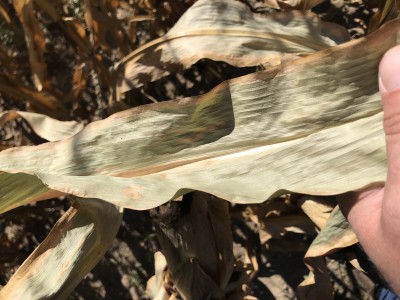Local Frost Advisories - What it Could Mean for Corn Producers in Southwest New
Joshua Putman, Field Crops and Forage Specialist
Southwest New York Dairy, Livestock and Field Crops Program

Frost can mean yield loss for crop producers, although the severity of damage varies based on crop maturity, topographical features and local climate conditions. A corn-killing freeze occurs when temperatures fall to 32 F for several hours or 28 F for a few minutes.
Damage occurs from freezing temperatures because living plant tissues contain water. As ice crystals form, they expand and puncture cell walls. As the temperatures rise during the morning, the ice crystals melt back to a liquid. The punctured cells lose water and nutrients and die. Frost damaged plant tissue often has a water-soaked appearance. This appearance later turns into brown, dead plant tissue. Damage will start to show up 1 to 2 days after a frost has occurred.
Late-season frost damage can affect grain quality and yield and is directly proportional to the stage of maturity and leaf tissue killed. Severe impacts on grain quality can occur at mid-dough, while moderate impacts are seen at the dent stage. By the time the kernel has reached half milk line, only minor impacts will occur to grain quality. Yield losses are negligible if frost occurs when grain moisture is below 35 percent. Differences among hybrids, overall plant vigor at the time of frost, and subsequent temperatures will all affect final grain quality and yield.
Severe plant tissue damage can lead to defoliation. If you suspect your corn has been damaged by frost, you should consider consulting the National Corn Handbook NCH-1 "Assessing Hail Damage to Corn" (Vorst, 1990). This publication has charts used by the National Crop Insurance Association for assessing yield loss due to defoliation. Knowing how to recognize frost damage and assess probable loss is important for decision making. An abbreviated version of the loss chart is shown in Table 7 below. For example, corn that was defoliated 20% at the milk stage would have 3% yield loss.
Frost damage can be difficult to identify late in the season as it is easily confused with common fungal leaf diseases such as northern corn leaf blight. If you have questions regarding the condition of your corn crop or if you don't have access to an electronic version of the "Assessing Hail Damage to Corn" guide, contact Josh Putman. For more information on corn maturity and frost, visit https://www.agry.purdue.edu/ex...
Upcoming Events
WEBINAR - Automated Milking Systems Efficiency: Balancing Focus on Individual Cows and System Optimization
May 8, 2024
Please join Cornell the SWNY team and MSU Extension for our talk with Dr. Pablo Silva Boloña on improving efficiency of Automated milking systems by focusing on milking settings for individual and group success.
Broiler Field Day at Sunny Cove Farm
June 6, 2024
Alfred Station, NY
Join us for a field day to explore broiler production, processing, and finances. Meghan Snyder of Sunny Cove Farm will be our host. She raises small batches of organic broilers, processing them on-farm under the 1,000 bird exemption.
Stockmanship and Stewardship 2024
October 25, 2024
Hamburg, NY
Save the date!! The event is one of 4 across the US and is a two-day educational experience featuring low-stress cattle handling demonstrations, Beef Quality Assurance educational sessions, facility design sessions, and industry updates.
Announcements
No announcements at this time.





